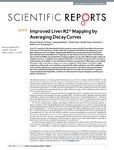Improved Liver R2* Mapping by Averaging Decay Curves.
| dc.contributor.author | Zhang, X | en |
| dc.contributor.author | Peng, J | en |
| dc.contributor.author | Wang, C | en |
| dc.contributor.author | Feng, Y | en |
| dc.contributor.author | Feng, Q | en |
| dc.contributor.author | Li, X | en |
| dc.contributor.author | Chen, W | en |
| dc.contributor.author | He, T | en |
| dc.date.accessioned | 2017-09-06T09:23:50Z | |
| dc.date.available | 2017-09-06T09:23:50Z | |
| dc.date.issued | 2017-07-21 | en |
| dc.identifier.uri | http://hdl.handle.net/10026.1/9898 | |
| dc.description.abstract |
Liver R2* mapping is often degraded by the low signal-to-noise ratio (SNR) especially in the presence of severe iron. This study aims to improve liver R2* mapping at low SNRs by averaging decay curves before the process of curve-fitting. Independently filtering echo images by nonlocal means (NLM) demonstrated improved quality of R2* mapping, but may introduce new errors due to the nonlinear nature of the NLM filter, during which the averaging weights may vary with different image contents at multiple echo times. In addition, the image denoising effect of the NLM may decline when no sufficient similar patches are available. To overcome these drawbacks, we proposed to filter decay curves instead of images. In this novel scheme, decay curves were averaged in a local window, each with a weight assigned according to the curve-similarity measured by the distance between one of the neighboring curves and the targeted one. The proposed method was tested on simulated, phantom and patient data. The results demonstrate that the proposed method can provide more accurate R2* mapping compared with the NLM algorithm, and hence has the potential to improve diagnosis and therapy in patients with liver iron. | en |
| dc.format.extent | 6158 - ? | en |
| dc.language | eng | en |
| dc.language.iso | eng | en |
| dc.subject | Algorithms | en |
| dc.subject | Computer Simulation | en |
| dc.subject | Humans | en |
| dc.subject | Image Enhancement | en |
| dc.subject | Image Interpretation, Computer-Assisted | en |
| dc.subject | Iron | en |
| dc.subject | Liver | en |
| dc.subject | Phantoms, Imaging | en |
| dc.subject | Signal-To-Noise Ratio | en |
| dc.subject | beta-Thalassemia | en |
| dc.title | Improved Liver R2* Mapping by Averaging Decay Curves. | en |
| dc.type | Journal Article | |
| plymouth.author-url | https://www.ncbi.nlm.nih.gov/pubmed/28733666 | en |
| plymouth.issue | 1 | en |
| plymouth.volume | 7 | en |
| plymouth.publication-status | Published online | en |
| plymouth.journal | Sci Rep | en |
| dc.identifier.doi | 10.1038/s41598-017-05683-5 | en |
| plymouth.organisational-group | /Plymouth | |
| plymouth.organisational-group | /Plymouth/REF 2021 Researchers by UoA | |
| plymouth.organisational-group | /Plymouth/REF 2021 Researchers by UoA/UoA01 Clinical Medicine | |
| plymouth.organisational-group | /Plymouth/REF 2021 Researchers by UoA/UoA01 Clinical Medicine/UoA01 Clinical Medicine | |
| plymouth.organisational-group | /Plymouth/Research Groups | |
| plymouth.organisational-group | /Plymouth/Research Groups/Institute of Translational and Stratified Medicine (ITSMED) | |
| plymouth.organisational-group | /Plymouth/Research Groups/Institute of Translational and Stratified Medicine (ITSMED)/CBBB | |
| dc.publisher.place | England | en |
| dcterms.dateAccepted | 2017-06-01 | en |
| dc.identifier.eissn | 2045-2322 | en |
| dc.rights.embargoperiod | Not known | en |
| rioxxterms.versionofrecord | 10.1038/s41598-017-05683-5 | en |
| rioxxterms.licenseref.uri | http://www.rioxx.net/licenses/all-rights-reserved | en |
| rioxxterms.licenseref.startdate | 2017-07-21 | en |
| rioxxterms.type | Journal Article/Review | en |


